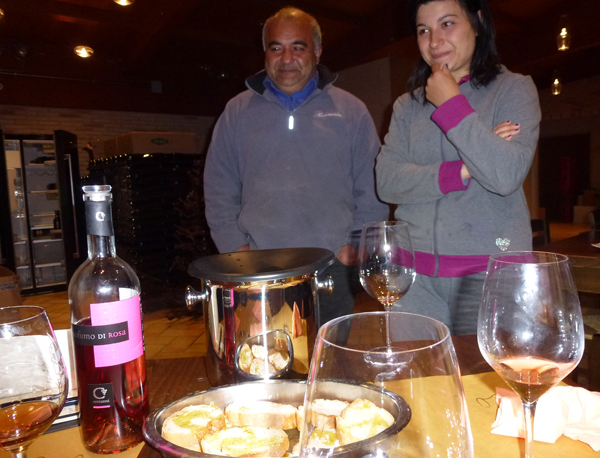Centanni – Vini di Famiglia
© by Neil Duarte
Situated in the hills just to the west of the town of Montefiore dell'Aso in the province of Ascoli Piceno in the region of Le Marche is the Azienda Agricola Biologica Centanni. Owned and run by Giacomo Centanni and his family, the Centanni winery produces approximately 110,000 bottles of wine/year using only grapes grown on Centanni's 32 hectares of hillside organic vineyards. As the title states in Italian, Centanni is a family owned winery whose products reflect the dedication and winemaking skill of the Centanni family.
Due to the late hour of our arrival, our tour of the winery was very brief. Senora Elisa Centanni, daughter of the owner, was our very knowledgeable hostess and tasting guide. She quickly showed us around the newly remodeled winery and ended the tour in the well equipped tasting room. There we sampled the Centanni offerings.

Giacomo Centanni and his daughter Elisa. PHOTO: Terry Duarte.
Centanni's products include red, white and rosé wines. They are the first winery in Le Marche to use the "tappo in vetro", literally the stopper in the glass, a unique replacement for the traditional cork which easily reseals the bottle if desired. In my brief exposure to this device, I was very impressed.
The first white wine offered for tasting was a 2011 Il Borgo Falerio DOC. Il Borgo is a 13% alcohol blend of 50% Trebbiano, 25% Passerina and 25% Pecorino. After the grapes are harvested by hand, they are soft pressed followed by an immediate drop in temperature via carbon dioxide to preserve the integrity of the fruit. Next is static decantation of the must and fermentation at low temperature. The color of the Il Borgo was a pale straw yellow, the nose light and fruity and the taste smooth and pleasant. It should be served at 10-12°C. I rated this wine an 86.
Our second white wine was a 2011 Passerina DOCG. This 100% Passerina wine is produced from hand picked grapes grown on rocky ground. After picking, the must is separated from the skins and cleaned without use of additional oxygen in order to preserve the grape aromas. Fermentation at 10°C follows for thirty days. When fermentation is completed, the wine is aged in stainless steel tanks for four months, filtered and bottled. The Passerina was a straw color, had a very fruity nose and a short and fruity taste. I did not rate it.
Third in the tasting was another white, a 2011 Pecorino DOCG. This 100% Pecorino wine shares the same fermentation details as the Il Borgo, but that is about all it shares. The wine was straw yellow in color, had light, subtle and slightly fruity bouquet and an elegant, long finish. This was an excellent white wine and I rated it a 90.
Next we tried a 2011 Profumo di Rosa Rosé. This wine was a 100% organically grown, hand selected Sangiovese. After being brought to the winery, the must and skin stay together in stainless steel for 24 hours. When the must has the desired color, the skins are separated and the must begins fermentation similar to a white wine. Fermentation is done at 10°C for thirty days followed by four months aging in stainless steel. The wine is then filtered before bottling. The Profumo di Rosa was the normal pink color and had a smooth, light finish. Not being knowledgeable about rosé wines, I did not rate this wine but I know that rosé lovers would enjoy it.
Moving to my favorite reds, the next wine was 2010 Rosso di Forca DOC, a 50% Montepulciano/50% Sangiovese blend. After destemming, the grapes are placed into fermentation tanks employing the replacement method. Prolonged maceration at controlled temperatures follows. The Montepluciano grapes are aged separately in oak barriques for three months before being combined with the Sangiovese grapes. The Rosso di Forca was deep garnet in color with a bouquet dominated by the Montepulciano aroma and had a light but long and very nice taste. I rated this medium wine a 90.
Our final wine was a 2010 Monte Floris Marche Rosso IGT. This wine is made from 100% hand selected Montepulciano organic grapes, taken from vines with a southern exposure. Must and skin are fermented together for fifteen days at 25°C in stainless steel tanks, the skins are removed and the wine remains in stainless steel after fermentation. Three months before bottling the wine is transferred to new oak barriques for aging. After filtration Monte Floris is bottled in July. Deep garnet in color, the wine had a strong Montepulciao bouquet and a long and smooth finish. I was very impressed with Monte Floris and gave it a 92 rating.
This was my final winery visit in Le Marche and a most enjoyable one. It is easy to see how Centanni received the Medaglia di Cangrande at VinItaly this year as the best winery in Le Marche. Our thanks go to the Centanni family, especially Elisa Centanni, our hostess for the tour and tasting. Centanni is now represented in the U. S. by ZGR Imports, Dana Point, CA. I highly recommend all of their wines.
All of the wineries we visited in Le Marche produced excellent wines and the owners, mostly families, were more than hospitable. If you are looking for an enjoyable vacation including winery visits, I urge you to consider Le Marche. You won't be overrun by hordes of noisy tourists.
December, 2012
